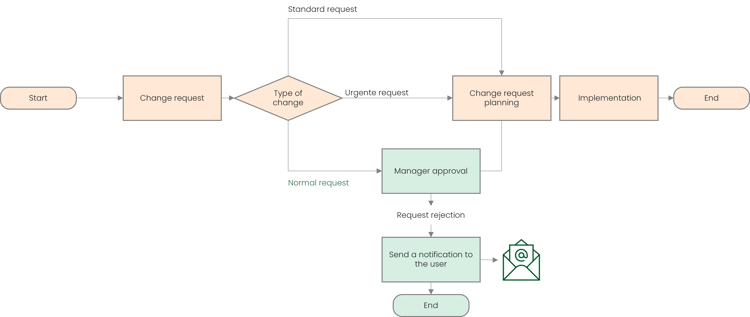
Change is an unavoidable reality in business. Whether it's a software update, new infrastructure, or an urgent intervention, each change must be well-managed. This helps reduce disruptions and ensures a smooth transition.
But how can you ensure these changes are well-managed and accepted by users? How can you avoid conflicts and not disrupt operations? This is where change enablement comes into play. Change enablement is a proactive approach to preparing, supporting, and securing IT services and infrastructure modifications.
Change request management answers requests to reduce risks, while change enablement focuses on getting everyone on board, smoothing processes, and quickly adopting new methods.
A good change enablement strategy reduces resistance lessens service disruptions and facilitates team and user transitions.
The difference between change request and organizational change enablement
In IT service management (ITSM), it's essential to understand the difference between a change request and change management. These two concepts are related, but they have distinct goals and processes.
Change request management
An ITSM change request pertains to IT services. It proposes to modify or update an element, configuration, or process related to IT systems or services. The main goal is to improve IT services, optimize operations, or resolve IT issues.
This process follows steps such as submitting the request, assessing the impact, approval, planning, implementation, and post-implementation evaluation. Each change request follows a structured process, including the following:
- Identifying the need: A user, an IT team, or an automated process can initiate a request.
- Assessing impacts and risks: Before approval, the changes are analyzed based on their impact on services, security, and operations.
- Approval and planning: The request must be validated by stakeholders or a Change Advisory Board (CAB) depending on its criticality.
- Implementation and monitoring: The changes are deployed according to a defined plan and monitored to ensure they function correctly.
Organizational change enablement
On the other hand, organizational change enablement is a broader field that encompasses managing change across the entire organization, including cultural, structural, and human aspects. It’s not limited to IT systems but applies to all business areas.
Organizational change enablement aims to plan, direct, and control organizational changes to minimize resistance, encourage the successful adoption of new practices, and achieve the company's strategic objectives.
This process involves identifying the need for change, planning and designing the change, communicating and engaging stakeholders, training and developing skills, and monitoring and evaluating the change's impact on the organization.
ITSM change enablement ensures:
- A smooth transition for change requests.
- Minimizes service interruptions.
- Ensures user acceptance.
Objectives:
- Reduce resistance to change.
- Optimize processes.
- Plan changes without impact.
- Maintain service stability.
In summary, although ITSM change requests and organizational change enablement aim to improve operations and achieve strategic goals, they differ in scope, specific objectives, and processes.
|
Examples of change management requests
|
Examples of change enablement
|
- Updating the operating system on servers.
- Need for new project management software, for example.
- Expanding the data center's storage capacity.
- Implementing an automated backup system.
|
- Redesign of the organizational structure
- Adoption of a new service management method
- Merger with another company
- Implementation of a new IT system
- Establishment of a new HR policy
- Revamp of a service catalog
|
The different types of changes
Not all changes are handled the same way in a structured ITSM environment. Change requests are categorized into three types depending on their complexity, impact, and urgency. This classification helps optimize their management, ensure service stability, and minimize risks associated with IT infrastructure modifications.
The three types of changes:
Standard changes
These changes are planned based on several factors, require prior approval, and can significantly impact infrastructure or operations. Their implementation follows a structured process that includes validations and risk assessments.
Example: Migrating part of the infrastructure to a new cloud provider to support business growth.
Normal changes
Planned according to several factors, they require authorization and impact operations and infrastructure.
Example: Acquiring new cloud infrastructure for new operations.
Urgent changes
These changes require immediate intervention because they create a critical situation that could affect the security or availability of services. They need special authorization and expedited processing, as they cannot wait for the standard approval cycle.
Example: Quickly installing a security update to fix a vulnerability on a server.
Organizations can correctly classify change requests, optimize processes, reduce risks, and balance innovation and service stability.

Sources of change requests
Change requests can originate from various sources and are not limited to incidents. A significant incident can trigger an urgent change request to restore a critical service quickly. However, not all changes are related to incidents.
For example, preventive maintenance on computer equipment is planned to prevent breakdowns and improve performance. This change is not a reaction to an immediate problem but a strategy to stabilize operations.
According to ITIL 4, change requests follow specific processes based on their nature and impact. A normal change requires formal approval and follows a structured process, while an urgent change is prioritized to limit service interruptions.
Then, thorough planning allows for synchronizing change with ongoing operations, avoiding conflicts (such as a critical update during a busy period), and anticipating necessary training.
Ultimately, a well-executed change relies as much on its technical framework as on its organizational adoption. By combining change requests management and change enablement, companies ensure a smooth transition, reduce resistance, and optimize their processes for sustainable efficiency gains.
Managing change requests is essential to ensuring a smooth and controlled organizational transition. Whether the changes are standard, normal, or urgent, each request follows a precise cycle. This requires good planning and clear communication.
By using best practices and anticipating impacts, companies can reduce resistance and maximize the value and efficiency of their transformations. In short, adopting a structured and proactive approach ensures a hassle-free evolution!













